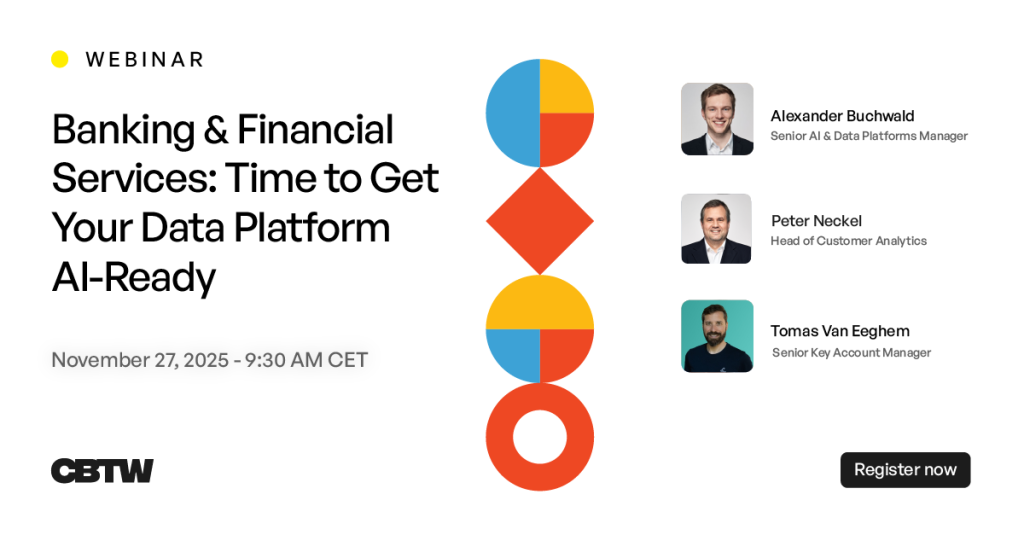For banks, data and AI is both a strategic asset and a regulatory challenge. Balancing performance, compliance, and innovation is increasingly difficult when legacy systems limit scalability and visibility. That was the case for our client, a leading financial institution in Europe, where fragmented data and outdated infrastructure were slowing analytics initiatives and delaying AI adoption.
To regain control, the bank needed a platform consolidating data, enforcing governance, and supporting future innovation, without compromising security. We partnered with their teams to design and deliver a modern, cloud-based Data Lakehouse Platform that now serves as the foundation for reliable insights, efficient compliance, and ready for enterprise AI use cases.
Context & Challenges: When Legacy Systems Hold Back Data-Driven Innovation in Banking
Our client, a major German bank, was facing the limits of its existing data infrastructure. As digital banking services expanded and customer expectations rose, the bank needed faster, more reliable access to data, without compromising on security or compliance.
Its legacy systems have become increasingly difficult to scale. Data was scattered across multiple sources, slowing decision-making and making it hard to support new AI and analytics initiatives. On top of that, the bank was under continuous regulatory oversight, with strict data-protection requirements that left no room for error.
The project carried high stakes: the institution needed to modernize its platform while keeping operations stable and secure. Deploying a cloud-based data architecture was the logical next step, but the organization had no prior experience with the Azure Data Lakehouse platform and faced tight deadlines to meet internal and regulatory milestones.
Beyond technical limitations, the bank also struggled to structure its project team efficiently. With multiple stakeholders across IT, data, and compliance, responsibilities were fragmented, creating delays and communication gaps. The absence of a unified data governance framework further increased risk, limiting trust in analytics and slowing the adoption of AI-driven initiatives.
TL;DR: Our client needed to build a scalable, secure, and compliant modern data platform. Fast enough to support ongoing operations, yet flexible enough to become the foundation for the bank’s AI ambitions.
Our Approach: Building a Secure and Scalable Data Lakehouse for Modern Banking
Starting point: Laying the foundations together
The first step was a deep dive into the bank’s existing landscape. Through extensive scoping workshops, we worked closely with business, IT, and data stakeholders to understand operational priorities, regulatory constraints, and expected outcomes.
Together, we defined the project’s must-haves, identified elements out of scope, and agreed on a phased roadmap that balanced ambition with delivery feasibility. This alignment ensured that every technical decision directly supported our client’s compliance, performance, and modernization goals.
Building a dedicated and collaborative project team
To ensure both speed and control, we assembled a multidisciplinary team, bringing together data engineers, cloud specialists, governance experts and project managers, and the client side. The setup followed an agile delivery model, allowing quick adaptation as requirements evolved.
We organized sprint planning sessions with clearly defined targets and regular checkpoints. This structure kept all teams synchronized, from business experts and technical leads to risk officers, fostering transparency and shared accountability throughout the process.
From through agile sprints and continuous validation
Each sprint combined design, development, and validation phases, with regular reviews to ensure compliance and data security standards were upheld. Intense collaboration workshops between our team and the bank’s internal teams helped address dependencies early, resolve technical blockers, and maintain delivery pace.
By leveraging pre-built accelerators and lessonslearned from previous regulated-industry implementations, we reduced setup time and minimized risk, keeping the project within the six-month timeline — all while ensuring business continuity and system integrity.
Ensuring and innovation hand in hand
Security and compliance were embedded from day one. Every architectural component, from data ingestion pipelines to governance models, was designed to align with financial regulations and internal audit frameworks.
This proactive approach not only ensured regulatory confidence but also created a trusted, AI-ready foundation for the bank’s future analytics and automation initiatives.

Benefits: Transformed, AI-Ready Banking Operations
By modernizing its data and AI infrastructure, our client gained a platform that is both operationally efficient and futureproof. Beyond meeting regulatory demands, the new Data Lakehouse has become the cornerstone of the bank’s AI-driven transformation, supporting faster insights, stronger governance, and measurable cost savings.
Futureproof scalability and reliability
The new cloud-based Data Lakehouse platform allows the bank to handle rising data volumes without compromising performance or security. By using an Infrastructure-as-Code (IaC) approach, the bank now benefits from a standardized, reproducible, and fully auditable infrastructure — a key requirement for internal IT controls and external regulatory audits. The architecture scales seamlessly across business units, ensuring uninterrupted access to analytics and reporting even during peak demand.
- Improved system scalability by over 40%, supporting growth in digital transactions.
- Zero downtime since deployment, guaranteeing uninterrupted access to business-critical data.
- IaC-driven deployments strengthened traceability and audit readiness, reducing operational risk.
Faster and more autonomous data processing
Switching from on-premise systems to the cloud significantly improved the bank’s ability to process large data workloads. While this did not directly impact end-customer interactions, it brought much higher stability and autonomy to internal data operations.
Pipelines that previously ran for well over 10 hours are now handled more reliably, reducing the risk of failures and the need for manual monitoring.
- Average processing performance improved on large data workloads.
- Long-running pipelines (often >10 hours) now run more reliably and with fewer interruptions.
- Increased autonomy in data processing reduces operational risk and dependency on runtime-sensitive systems.
Strong data governance and compliance confidence
We implemented a robust data governance framework embedded at every level of the data lakehouse platform.
To fulfill regulatory requirements, the platform leverages the catalog of Databricks for centralized data access control, ensuring fine-grained permissions across all datasets. Role-Based Access Control is integrated with Azure Active Directory to enforce identity-driven security policies. Additionally, automated audit logging and data and AI lineage tracking provide full transparency for compliance teams, supporting regulatory audits and internal risk assessment.
- Unified and centralized data and AI governance framework
- Automated data lineage tracking for transparency and impact analysis
- Compliance-ready architecture aligned with banking regulations
- Automated audit logging to support regulatory compliance and internal audits
Operational efficiency and cost optimization
With the adoption of Infrastructure-as-Code and automated deployment workflows, the platform now operates with minimal manual intervention. Maintenance costs and resource allocation are optimized, ensuring that the teams can focus on higher-value initiatives.
- 50% reduction in infrastructure management costs compared to the previous setup.
- Faster deployment cycles and simplified environment replication for new projects.
Foundation for AI-driven use cases
Designed with future use cases in mind, the Data Lakehouse now provides a unified and trusted source of truth to power AI and advanced analytics. The platform implements MLOps practices to manage the complete machine learning lifecycle, including experiment tracking, model versioning, and automated deployment across development and production environments. It is optimized for big data AI workloads using Azure Databricks’ distributed processing, ensuring scalability and compliance for advanced analytics and predictive modeling.
We established a clear concept for Development, Test, and Production environments, enabling controlled progression from experimentation to deployment. Data scientists work with reliable and consistent datasets in Dev before deploying governed models in Production, ensuring reliability, compliance, and reproducibility
- Ready-to-deploy architecture for machine learning and Generative AI use cases.
- Clear data & AI lineage and governance supporting responsible, compliant AI development.
- Defined multi-environment concept enabling controlled model lifecycle and reliable data access for data scientists.
- Integrated MLOps framework for automated training, validation, and deployment across environments, ensuring scalability and compliance.
Team Involved
Delivering a secure and scalable Data Lakehouse Platform in a banking context required close collaboration between our data, cloud, and security experts.
The project team combined technical precision with regulatory awareness to ensure every milestone aligned with both performance and compliance objectives.
- Data Architects: Ensuring a scalable, well-governed Lakehouse by designing a robust data architecture that delivers clean, reliable, and consumable data.
- Databricks Solution Architect: Defined the platform’s overall design and governance to ensure secure, scalable, and efficient data and AI development.
- Cloud Engineers: Built and designed the overall platform infrastructure on Azure using Infrastructure-as-Code for secure, consistent and automated delivery.
- Data Governance and Security Specialists: Embedded regulatory requirements and audit mechanisms across the platform, ensuring full traceability.
- Project Managers and Business Analysts: Maintained alignment between technical progress and business priorities, securing stakeholder confidence at every step.
We delivered the project end-to-end with an interdisciplinary expert team, ensuring rapid and high-quality implementation. Internal colleagues were part of the journey from the beginning, and we actively enabled them in lakehouse and Azure capabilities to ensure long-term self-sufficiency
Technologies Used
The implementation of the bank’s Modern Data Platform relied on a robust, cloud-native ecosystem designed for scalability, security, and AI readiness.
Each technology was selected to meet specific business and regulatory needs while ensuring seamless integration across teams and systems.
- Microsoft Azure: Served as the foundation for the Data Lakehouse, providing a secure, compliant environment aligned with the high regulatory requirement of the financial sector. Azure’s flexibility enabled fast provisioning and scaling across data workloads.
- Azure Databricks: Unified data engineering and analytics platform, enabling faster data processing and advanced analytics development.
- Terraform (Infrastructure-as-Code): Standardized and automated environment deployment, improving reproducibility, compliance, and operational efficiency.
- Power BI: Delivered secure data visualization and reporting, allowing business teams to explore insights directly from governed datasets.
- DevOps and Toolchain: Integration of the solution into the existing toolchain and the design of a robust Azure-based DevOps process.
